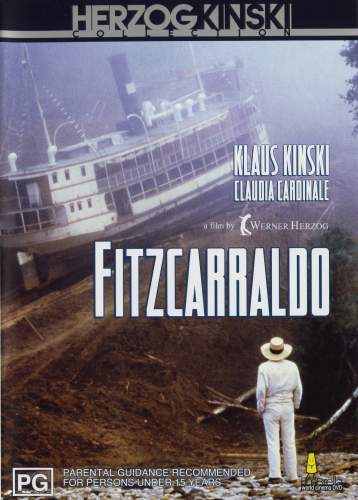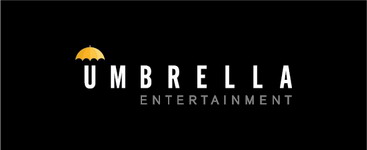Fitzcarraldo (1982) |
|
Fitzcarraldo (1982) |
|


|
| BUY IT |
| General | Extras | ||
| Category | Adventure |
Main Menu Audio Audio Commentary-Werner Herzog (Dir.), Lucki Stipetic (Prod.) & Norman Hill Biographies-Cast & Crew Gallery-Photo-Stills Theatrical Trailer-In German Trailer-Herzog Collection |
|
| Rating |

|
||
| Year Of Production | 1982 | ||
| Running Time | 150:44 (Case: 157) | ||
| RSDL / Flipper | RSDL (82:33) | Cast & Crew | |
| Start Up | Menu | ||
| Region Coding | 1,2,3,4,5,6 | Directed By | Werner Herzog |
|
Studio
Distributor |
 Umbrella Entertainment |
Starring |
Klaus Kinski José Lewgoy Miguel Ángel Fuentes Paul Hittscher Huerequeque Enrique Bohorquez Grande Otelo Peter Berling David Pérez Espinosa Milton Nascimento Ruy Polanah Salvador Godínez Dieter Milz William L. Rose |
| Case | Amaray-Transparent-Secure Clip | ||
| RPI | $29.95 | Music | Popol Vuh |
| Video | Audio | ||
| Pan & Scan/Full Frame | None |
German Dolby Digital 5.1 (448Kb/s) English Dolby Digital 5.1 (448Kb/s) English Audio Commentary Dolby Digital 2.0 (224Kb/s) |
|
| Widescreen Aspect Ratio | 1.85:1 | ||
| 16x9 Enhancement |
 |
||
| Video Format | 576i (PAL) | ||
| Original Aspect Ratio | 1.85:1 | Miscellaneous | |
| Jacket Pictures | Yes | ||
| Subtitles | English | Smoking | Yes |
| Annoying Product Placement | No | ||
| Action In or After Credits | No | ||
Brian Sweeney Fitzgerald (Klaus Kinski), the Fitzcarraldo of the title, and his brothel-keeping girlfriend (Claudia Cardinale) travel 1,000 miles across South America to see a performance of Ernani with Enrico Caruso and a dubbed from the pit Sarah Bernhardt (the latter played by a man for no apparent reason). Inspired by the experience, Fitzcarraldo decides that he will bring opera to the settlement of Iquitos. The area is amongst the wealthiest on earth thanks to rubber plantations, but Fitzcarraldo's own money-making schemes, like a trans-Andean railway and an ice manufacturing concern, have been failures.
After a discussion with one of the rubber barons he is inspired to purchase a claim to an area of the Amazonian jungle that is rich with rubber trees but lies upstream of impenetrable rapids on a tributary of the Amazon. But according to a map, another tributary almost joins it beyond the rapids, and Fitzcarraldo buys an old steamship with a scheme in mind to get the steamship across the gap - by dragging it over the steep mountain between the two rivers.
In some respects the movie seems to be an excuse for Werner Herzog to drag a boat over a mountain, and can be seen as a depiction of the filmmaker's obsessions as well as those of Fitzcarraldo. After a shaky beginning as Fitzcarraldo tries to convince the local businessmen to invest in his schemes, the film really takes off once he and his reluctant crew head off up the river. The seemingly untouched rainforests form an eerie backdrop to the action, involving a tribe of seemingly hostile Indians who see the white-suited Fitzcarraldo as a god of ancient prophecies. Whereas Herzog's earlier collaborations with Kinski dealt in madness and eventual destruction, this film is warmer and more upbeat, and it is this aspect that raises it above the ordinary.
The production was fraught with difficulties. Kinski was not the original choice for the role, but after a few setbacks the original leading actors Jason Robards and Mick Jagger withdrew, and Herzog was forced to call on his old colleague. The problems with the shoot are well captured in the Les Blank documentary Burden of Dreams, which is just as impressive as the movie. It is a pity that this documentary is not included as an extra on this release. Kinski produced his usual tantrums, so much so that the local Indians being used as extras offered to kill Kinski on Herzog's behalf, an offer which he reluctantly declined.
A compelling study of obsession and achievement, this film gets its second DVD release in Region 4, this time as part of the Herzog-Kinski Collection.
The film is transferred in an aspect ratio of 1.85:1 and is 16x9 enhanced.
It is possible to imagine that the transfer could be better. While it is reasonably sharp, detail is lacking most of the time. Fine detail such as grass and leaves seems blurred and lacking in definition. I suspect that it is due in part at least to this being an NTSC to PAL conversion, though I cannot be completely certain of this. Colour is not especially vivid, with the greens of the jungle coming across best. Blacks are solid enough for undistracted viewing.
Some mild aliasing is present. There is also mild motion blurring. Grain is omnipresent, and much of the time there is more than I would have liked.
Film artefacts are few, with occasional faint scratches and a darker one at 58:32.
The real problem with this disc is the subtitles. They are provided in a yellow font and are quite easy to read, although the spelling is American. But not all of the dialogue is translated. In a lot of the dialogue the first line is translated but the second is not, so often the point of things is missed. This reaches its peak (or nadir if you prefer) when Fitzcarraldo and his remaining crew are atop the platform in the jungle, and Fitzcarraldo reveals what he wants to do with the ship. We hear it in German (with the words "schiff" and "berg" - "ship" and "mountain") but the line is untranslated. This is extremely shoddy and very annoying, and reduces the worth of the set in which this film is released.
The disc is RSDL-formatted with the layer change placed at 82:33 at a cut.
| Sharpness | |
| Shadow Detail | |
| Colour | |
| Grain/Pixelization | |
| Film-To-Video Artefacts | |
| Film Artefacts | |
| Overall |
There is a choice of Dolby Digital 5.1 soundtracks in German and English. The default, which I listened to, is the German one but the original filming had the actors speaking their lines in English. In both cases the soundtrack is dubbed, however.
Dialogue is quite clear throughout. There is little in the way of distortion and no hiss, and the sound would be reasonable if the soundtrack was mono. As it is, the surround audio is not that impressive, being mostly geared to the front speakers. There is occasional surround information but no significant directional effects. The subwoofer springs into life a couple of times in the sequence involving jungle drums and dynamite exploding, but otherwise it remains dormant.
The fine music score includes material from Herzog's regular collaborator Popol Vuh, as well as excerpts from Verdi and recordings of Caruso.
| Dialogue | |
| Audio Sync | |
| Clicks/Pops/Dropouts | |
| Surround Channel Use | |
| Subwoofer | |
| Overall |
The voice of Caruso is heard over the static main menu.
The usual fine commentary by Herzog, with occasional questions from Hill and very little input from Stipetic. It covers the production problems, the frequent tantrums by Kinski, and plenty of background information on the actors and sets. Herzog also points out a few long shots in which a tiny speck he identifies as Mick Jagger appears.
Single page text biographies of director and star.
A few production stills and behind the scenes shots.
The original German trailer with burned-in English subtitles.
Trailers for the other five releases in this set.
NOTE: To view non-R4 releases, your equipment needs to be multi-zone compatible and usually also NTSC compatible.
By all accounts the content of the Region 1 release is virtually identical to the Region 4, with only an additional text biography of Popol Vuh and alternative stereo soundtracks in both languages being the points of difference. The Region 2 appears to be the same as the Region 4. Based on screencaps I have seen the Region 1 looks better than the Region 2. If the Region 4 is indeed an NTSC to PAL conversion, then the Region 1 is to be preferred.
There is a German release of the film on two discs which contains the Burden of Dreams documentary, but there are no English subtitles on this release. The documentary has been released in Region 1 by the Criterion Collection.
An excellent film, which with Aguirre is the finest collaboration of these two men. A pity it is compromised by the subtitling.
The video quality is average.
The audio quality is good.
Some useful extras.
| Video | |
| Audio | |
| Extras | |
| Plot | |
| Overall |
| Review Equipment | |
| DVD | Pioneer DV-S733A, using Component output |
| Display | Sony 86CM Trinitron Wega KVHR36M31. Calibrated with Ultimate DVD Platinum. This display device is 16x9 capable. |
| Audio Decoder | Built in to DVD player, Dolby Digital, dts and DVD-Audio. Calibrated with Ultimate DVD Platinum. |
| Amplification | Sony TA-DA9000ES |
| Speakers | Main: Tannoy Revolution R3; Centre: Tannoy Sensys DCC; Rear: Richter Harlequin; Subwoofer: JBL SUB175 |